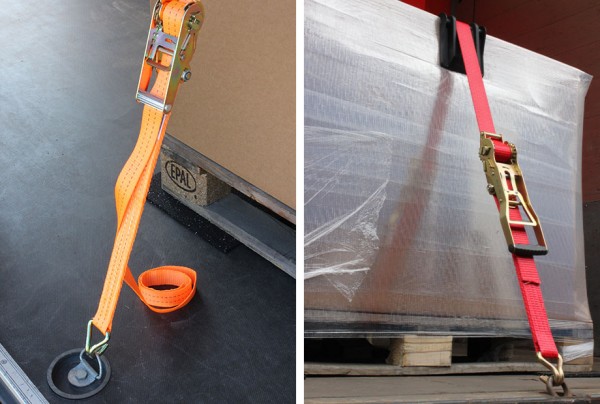When a free-standing cargo on a transporter is secured only by a single application of force, for example between cargo and base surface or between individual transported goods, this is an example of force-fit cargo securing. The best known and most frequently used method is tie-down lashing with the aid of a lashing device (lashing straps, lashing chains or lashing ropes). In addition, lashing tracks can be used, which are also easy to fit at a later date.
Force-fit equals “simple lashing down”
Professional tie-down lashing ensures the cargo is secured by a force fit. In this method, the goods are pressed onto the surface of the vehicle by tension or lashing straps, so that the frictional force is increased, which prevents the various goods from slipping. It is the coefficient of friction (µ) that is of importance here.
Tip: Not all vehicles are suitable for this type of cargo securing. The decisive factor here is the body strength of the commercial vehicle or the trailer used in accordance with DIN EN 12642.
Force fit for cargo securing
In many cases, securing goods with a form fit is no longer sufficient. This can be the case if the weight of the goods to be transported is very high or if they are too bulky. As an alternative, force-fit securing of the cargo must then be used to prevent slippage.
The force-fit method is guaranteed with the aid of tie-down lashing. In this process, the goods are fixed with a force-fit to or on the vehicle using aids such as lashing chains, lashing straps or wire ropes at specific anchorage points, covering nets and lashing tracks. The respective lashing device is guided over the goods and hooked into lashing points on both sides of the vehicle, for example. Then a tensioning element such as a ratchet is used to tighten the lashing device.
Insert flexible tracks
One of the main advantages of lashing tracks made of aluminium is their very low dead weight. This makes these securing products quick and very easy to install. The latter is done with rounded head/countersunk screws, rivets or special liquid adhesive, depending on the model.
Lashing tracks can usually be recessed as well as attached – depending on the design. This type of equipment/securing is especially suitable for retrofitting. Furthermore, lashing tracks offer the great advantage that the standardised hole dimensions in combination with fittings and locking rods can significantly increase the cargo securing. A locking rod is used, for example, in vertical applications on tarpaulin vehicles/box trucks between the floor track and the ceiling track and thus secures boxes and other transport goods against slipping.
Lashing tracks are equipped with a variety of profiles (e.g. airline track) so they can be used individually in lorries (box/tarpaulin bodies) and standard transporters, for example, using suitable accessories. An optimal form-locking fit is created when lashing tracks are combined with shoring beams, as these are located close to the goods.
Difference between form-fit and force-fit
While form-fit cargo securing prevents the goods from slipping, for example by using a combination of gapless and flush loading, diagonal or transverse lashing and using locking rods and shoring beams, force-fit securing achieves the same ends simply with tie-down lashing.
With the latter, a palletised cargo for example, is fixed on or in transporters with equipment such as lashing straps made of textile material.
Guidelines for lashing devices with force fit
When securing goods with a force fit, it must be ensured that the permissible forces and production methods of the belts used make them suitable to meet the individual requirements, and that they are labelled accordingly:
- Preload force in decanewtons – daN (standard tension force – STF)
- Standard hand force in daN (SHF) 50 daN
- Permissible lashing capacity (LC value), for example, with “straight tension” identifier
- Material: PES
- DIN EN 12195-2
- Length specification
- Warning: “Must not be used for lifting”
- Name/symbol of the manufacturer
- Traceability code
- Year of manufacture
- Elongation in % at LC
- CE marking NOT permissible!








